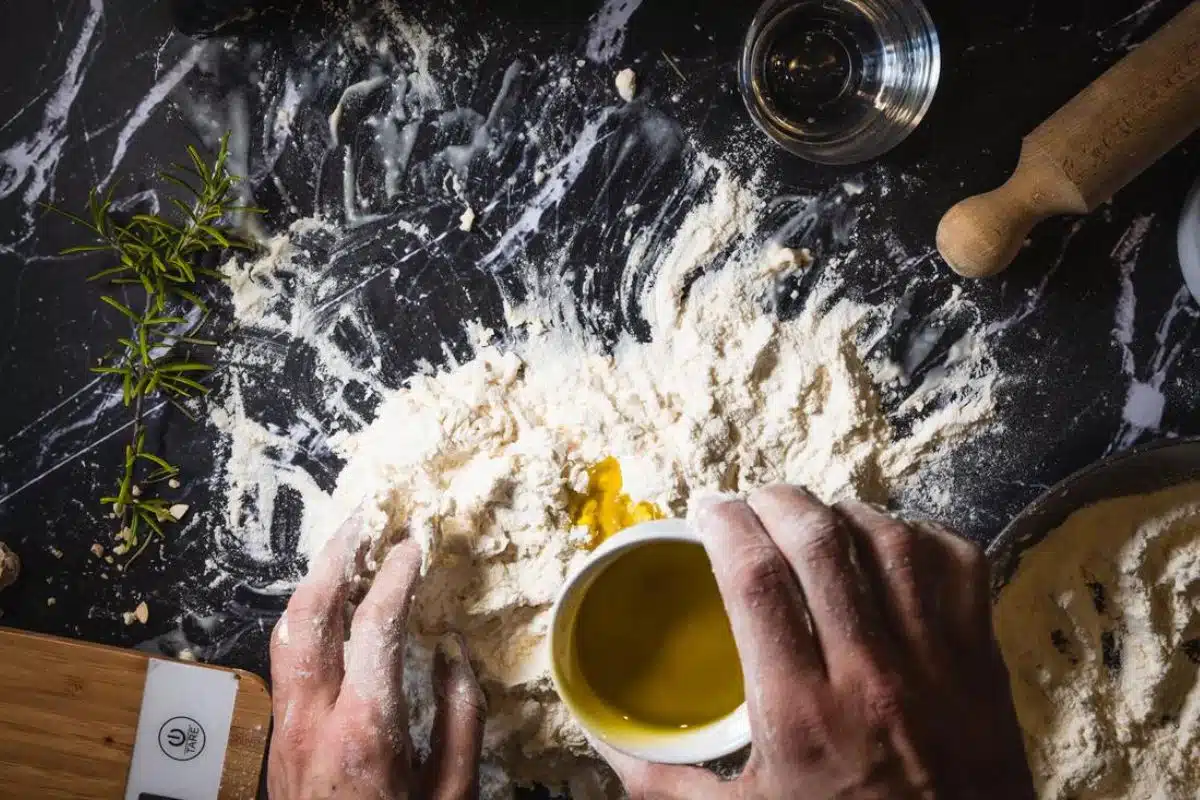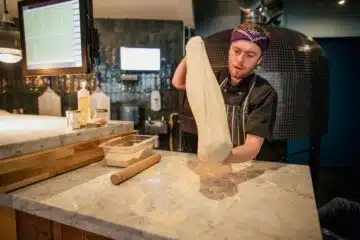To enhance pizza dough flavor, let it ferment longer or add herbs and garlic. Cold fermentation develops complexity over time.
Crafting the perfect pizza dough is both an art and a science. Achieving a robust flavor profile can transform a good pizza into an exceptional one. The secret lies in the fermentation process and the ingredients used. By extending the fermentation period, the dough gains a richer, deeper taste as the yeast has more time to work its magic.
Meanwhile, incorporating aromatic herbs or a hint of garlic into the dough introduces an additional layer of flavor. With these simple tweaks, home bakers and chefs alike can elevate the taste of their homemade pizzas, delighting the palate of anyone who takes a bite. Remember, patience and quality ingredients are the keys to a flavorful dough that stands out in the world of pizza lovers.

Introduction To Pizza Dough Flavor
Every slice of pizza owes its mouthwatering taste to the foundation that holds all the toppings – the crust. Understanding the flavor profile of pizza dough becomes crucial for a delectable experience. It’s not just about the cheese or the toppings; the dough itself must be a symphony of flavors. In this journey of taste, the pizza crust is the unsung hero, and enhancing its flavor can transform your pizza from good to great.
Importance Of Flavor In Pizza Crust
It’s the crust that first hits the taste buds. A pizza with a flavorful crust elevates the entire dish. Guests notice the difference immediately. It’s not just about texture; the crust’s taste is significant. We aim for a dough that complements every slice.
Elements That Influence Dough Taste
Multiple elements come into play when boosting your pizza dough’s taste. From the type of flour to the fermentation process, each has a role:
- Flour type – Different flours equal different flavors.
- Yeast – Yeast not only helps the dough rise but also enhances taste.
- Water – The quality of water can impact the dough’s taste.
- Salt – A flavor enhancer, salt is crucial for balancing taste.
- Sugars and Fats – They add richness and depth to the dough.
- Fermentation time – Longer fermentation equals more complex flavors.
Choosing The Right Flour
Are you on a quest to bake the perfect pizza with delicious, flavorful dough? Choosing the right flour is the secret ingredient. The type of flour you select can transform your crust from average to exceptional. Let’s dive into how different flours affect your dough’s taste and texture.
Types Of Flour And Their Impact On Flavor
The type of flour you choose directly impacts the flavor of your pizza dough. Here are a few options:
- All-purpose flour: Mild taste, versatile, good for a classic crust.
- Bread flour: Slightly nutty flavor, ideal for a chewy, thick crust.
- Whole wheat flour: Rich, earthy taste, adds a hearty texture.
- 00 flour: Authentic Italian flavor, perfect for a thin, crispy base.
The Role Of Protein Content In Flour
The protein content in flour defines your dough’s texture and flavor. Higher protein equals more gluten, which gives a chewier crust. Lower protein means a tender bite. See this comparison:
| Type of Flour | Protein Content | Crust Texture | Flavor Profile |
| All-purpose flour | 9-11% | Soft, slightly chewy | Mild, neutral |
| Bread flour | 12-14% | Chewy, structured | Hearty, rich |
| Whole wheat flour | 14-16% | Dense, thick | Nutty, robust |
| 00 flour | 11-12% | Crispy, light | Delicate, refined |
Selecting the right flour will set the foundation for a pizza that boasts intriguing flavors and irresistible textures. So, next time you knead your dough, keep these tips in mind for an enhanced pizza experience.
Water: The Flavor Enhancer
Many people overlook water’s role in pizza dough flavor. Yet, it’s a key player. Imagine your dough as a blank canvas. Water is like the paint that brings the picture of flavor to life. It’s not just about hydration. The water quality, its temperature, and the amount can affect your pizza’s taste in unexpected ways.
Effects Of Water Quality On Dough Taste
Pure water means pure flavor. Water quality matters.
- High mineral content can add a subtle complexity to the dough.
- Water with lots of chlorine can make the yeast sad, and your dough tastes flat.
- Filtered or spring water is often the safest bet for consistent, delicious dough.
Temperature Considerations For Optimal Flavor
Water’s temperature helps the yeast work its magic. Think of yeast as tiny chefs in your dough. They like it not too hot and not too cold.
| Temperature | Yeast Activity | Flavor Impact |
| Warm | Speedy chefs | Faster rise, less flavor |
| Cool | Slow chefs | Longer rise, more flavor |
| Just Right | Happy chefs | Perfect rise, great flavor |
Water temp should be around 75°F (24°C) for optimal dough love. This gives a good rise and excellent taste.
The Fermentation Process
Fermentation is the secret behind delicious pizza dough. It’s a time-honored technique that not only helps the dough rise but also amplifies the flavor. During this magical process, yeast eats the sugars in the flour, creating carbon dioxide and alcohol, which add complexity and a distinctive taste to the dough.
Long Fermentation For Depth Of Flavor
For that unforgettable characteristic tang in pizza crust, long fermentation is key. This method allows the dough to ferment slowly, enhancing the taste to its fullest potential. The longer the ferment, the more pronounced the flavors.
- 24-hour fermentation yields a notable difference in taste.
- Some artisans even suggest a 48 to 72-hour fermentation period for the ultimate flavor.
Yeast Types: A Flavor Difference
The type of yeast you choose can impact the flavor of your pizza dough. Each yeast variety has its unique characteristics.
| Type of Yeast | Flavor Profile |
| Active Dry Yeast | Provides a classic, bready flavor. |
| Instant Yeast | Offers a milder taste and works faster. |
| Sourdough Starter | Gives a tangy, distinctive edge. |
Choosing between an active dry, instant, or natural sourdough starter will affect the final flavor of your crust. Experiment with different yeasts to find your preferred taste.
Salt And Sugar: More Than Taste
When crafting pizza dough, the ingredients you add influence more than taste. Salt and sugar play pivotal roles in the dough’s final flavor profile and texture. They act as essential agents in creating that perfect bite. Mastering their balance can elevate homemade pizza to a professional level.
Balancing Salt For Enhanced Flavor
Salt is crucial for flavor balance and dough structure. Without it, pizza dough tastes bland and lacks complexity. A well-measured amount enhances the dough’s overall flavor. It even strengthens gluten networks, yielding a superior texture. Keep the following points in mind:
- Use the right amount: Typically, 1-3% of the flour’s weight in salt is ideal.
- Avoid table salt if possible; opt for sea salt or kosher salt for a pure taste.
- Even distribution is key. Ensure salt is well integrated into the dough.
Sugar’s Subtle Effect On Crust Color And Taste
Sugar also significantly shapes the pizza experience, affecting both crust color and taste. Its presence is subtle, but with thoughtful integration, the results are notable. Here’s why:
| Function | Impact |
| Browning | Encourages caramelization for a golden crust. |
| Yeast Nutrition | Fuels yeast for a lighter texture. |
| Flavor Balance | Offsets saltiness adds a subtle sweetness. |
Remember, too much sugar can lead to over-browning. Aim for just 1-2% of your flour’s weight. It will ensure a beautiful crust with the perfect hint of sweetness.

Incorporating Fats For Tenderness
Every pizza lover dreams of the perfect dough: stretchy, fluffy, with a touch of crispiness. Adding the right fats can make that dream come true. Fats bring tenderness and flavor, transforming ordinary dough into a delectable masterpiece. That soft bite and subtle richness in your pizza base? Fats deserve the credit. To level up your pizza dough game, let’s dive into the world of fats!
Choosing The Right Fats For Flavor
Fats are flavor carriers, and using the right type can elevate your dough. Here are the top picks:
- Olive oil – Adds a distinct, fruity flavor.
- Butter – Offers a rich, creamy taste.
- Coconut oil – Brings a subtle, sweet note.
Each fat adds its unique character to the dough. It’s all about personal preference and the flavor profile you’re aiming for.
How Fats Change Dough Properties
Fats do more than add flavor; they change your dough’s texture and performance. Here’s how:
| Fat | Effect on Dough |
| Olive oil | Increases extensibility and creates a tender crust. |
| Butter | Enhances flavor and adds suppleness to the dough. |
| Coconut oil | Improves texture and adds mild sweetness. |
Fats coat the flour proteins, which limits gluten formation. This results in a dough that’s easier to handle and gentler on the palate.
Additions That Pack A Punch
Craving a flavor boost for your homemade pizza dough? Tantalize taste buds with smart, zesty additions! Transform basic dough into an irresistible base with just the right punches of savoriness. Enhance each bite with herbs, spices, cheese, and other delicious mix-ins. Explore these game-changing ingredients and prepare for a memorable pizza experience!
Herbs And Spices For A Flavorful Twist
Fresh herbs and bold spices make a world of difference. Create a signature dough that guests will love. Experiment with these options:
- Oregano: Classic, earthy aroma.
- Basil: Fresh and slightly sweet.
- Thyme: Subtle, minty layers of flavor.
- Garlic Powder: A robust, universal favorite.
- Crushed Red Pepper: For a spicy kick.
- Rosemary: Piney scent and a woodsy note.
Knead these directly into your dough. Start small. Taste and adjust as you go.
Cheese And Other Tasty Mix-ins
Infuse cheese and surprise elements into the dough. These add savory depth:
| Cheese | Notes | Mix-ins | Impact |
| Parmesan | Salty and nutty. | Olives | Saltiness and texture. |
| Cheddar | Rich and tangy. | Sundried Tomatoes | Chewy sweetness. |
| Gouda | Buttery and smooth. | Chopped Nuts | Crunch and richness. |
Grate or cube cheese into the dough blend. For mix-ins, ensure they’re finely chopped. They should blend evenly for the perfect bite.
Techniques To Enhance Flavor
Creating an unforgettable pizza starts with perfecting the dough. Great flavor takes time and technique. Read on to uncover the secrets to transforming simple pizza dough into a culinary masterpiece.
Cold Proofing For Complexity
Cold proofing, or cold fermentation, is a slow-rise technique that elevates the depth and character of your pizza dough. By letting your dough rest in the refrigerator for 24 to 72 hours, the yeast performs its magic at a slow pace, allowing flavors to develop fully. Not only do these extended cold periods enhance taste, but they also improve the dough’s texture. Follow these simple steps to try cold proofing:
- Mix your dough as usual and shape it into a ball.
- Place the dough ball in a sealed container or a bowl covered with plastic wrap.
- Let it rest in the refrigerator for up to three days.
- Remove from the fridge and let it warm up slightly before stretching and baking.
Autolyse Method For Flavor Development
The autolyze method is a simple yet powerful step to adopt in your pizza dough-making process. This strategy involves mixing flour and water before adding yeast and salt. Let the mixture rest for at least 20 to 30 minutes. This resting period allows enzymes to break down the starches into simple sugars, which the yeast can then readily consume, leading to a richer flavor and a tender crumb structure. Remember to:
- Mix the flour and water and let it rest.
- After the autolyze period, add the yeast and salt to proceed.
- Knead the dough lightly to incorporate all ingredients.
- Follow with your preferred proofing technique.
Baking Tips For The Perfect Crust
Your journey to a mouthwatering pizza begins with the crust. Let’s embark on a quest for the ultimate pizza dough flavor. Crisp edges and a tender base can transform your homemade pizza. Delve into these baking secrets.
Oven Temperature’s Role In Flavor
Temperature is key for a flavorful crust. A hot oven creates a beautiful browned base brimming with taste. Ensure your oven is at the right heat before the dough goes in.
- Preheat your oven to between 450-500°F (232-260°C).
- A pizza stone or steel can hold and transfer heat effectively.
- For crispier crust, leave the pizza in for an extra minute.
Steaming For A Crusty Finish
Steam can elevate the crust’s texture. Adding steam during baking gives your pizza edge an irresistible crunch.
- Place a metal pan with hot water at the oven’s bottom.
- Slide the pizza onto the middle rack quickly.
- Close the oven door swiftly to trap steam.

Troubleshooting Dough Flavor Issues
If your homemade pizza dough seems off, don’t worry! Flavor issues are common and fixable.
Common Mistakes And Solutions
Inadequate fermentation can lead to bland dough. Let your dough rise slowly in the fridge for better taste.
Too much yeast creates a yeasty flavor. Reduce the amount, and give your dough more time to rise.
Using poor-quality flour affects the taste. Switch to high-protein bread flour for a better base.
A lack of salt can make your dough taste flat. Salt also controls fermentation, so be sure to add the right amount.
Not incorporating olive oil results in losing a nice aroma. Add a bit to your recipe for flavor and texture.
- Fermentation: Slow rise for more flavor
- Yeast: Use less, rise longer
- Flour: Opt for high-quality
- Salt: Essential for taste and control
- Olive Oil: Adds flavor and richness
Adjusting Recipes For Personal Taste
To change your dough’s taste, start with small adjustments. Make notes on changes and test again.
Flavor enhancement: Add spices like garlic powder, herbs, or a touch of honey. Just a little goes a long way.
Hydration levels control chewiness and crust. More water means a lighter, airier crust.
If you prefer a tangy sourdough flavor, try using a starter instead of commercial yeast.
- Experiment with spices and condiments
- Adjust water for desired crust texture
- Use a starter for complex tastes
Conclusion: Mastering Pizza Dough Flavor
Mastering pizza dough flavor is a rewarding journey in the craft of pizza-making. Rich, nuanced pizza dough does not happen by chance. It results from understanding key elements and refining skills through experimentation. Let’s wrap up our deep dive into crafting a delicious pizza base with a recap and some words of encouragement.
Summarizing Key Flavor Factors
The quest for irresistible pizza dough flavor begins with fresh, quality ingredients. Your flour, yeast, water, salt, and any additional flavor enhancers must be top-notch. The right proportions and proper fermentation time greatly influence flavor development. Here’s a quick summary:
- Flour Quality: Opt for high-protein, unbleached flour for a robust taste.
- Yeast Freshness: Use fresh yeast for consistent rise and flavor.
- Hydration: A well-hydrated dough means a tender, flavorful crust.
- Salt: Salt regulates fermentation and enriches the taste. Don’t skimp!
- Fermentation: Slow fermentation at a cool temperature enhances complexity.
Encouragement To Experiment And Perfect Techniques
Every pizza maker’s journey is unique. Do not shy away from trial and error. Fine-tune your methods with each batch. Let your senses guide you. Trust your nose, touch, and taste. Remember, practice breeds confidence and skill. Remain patient and persistent. You are on your way to crafting a pizza dough that others will rave about for years to come!
Frequently Asked Questions
Why Does My Pizza Dough Taste Bland?
Your pizza dough may taste bland due to insufficient salt, underseasoning, or lack of fermentation time, which develops flavor. Use a taste-tested recipe and allow proper rise time for improved taste.
How To Enhance Pizza Flavor?
To enhance pizza flavor, use high-quality, fresh ingredients and preheat your oven. Incorporate herbs like basil or oregano, and drizzle olive oil before serving. Experiment with different cheeses for richer taste profiles.
How Do You Make Pizza Dough Not Taste Bland?
To enhance pizza dough flavor, add a pinch of salt, use quality olive oil, and let the dough ferment longer. For extra taste, incorporate herbs like oregano or garlic powder.
How Do You Make Pizza Dough Taste Nice?
Allow the pizza dough to ferment slowly to enhance its flavor. Use quality flour, fresh yeast, and proper salt. Infuse with herbs like garlic or rosemary. Opt for a pre-ferment, like a sponge, for depth. Keep the water-to-flour ratio balanced for the desired texture.
Conclusion
Embarking on the quest for the ultimate pizza dough flavor brings a delightful edge to home cooking. Remember, the secrets lie in fermentation time, quality ingredients, and a dash of patience. Perfecting your dough elevates not just your pizza but your baking prowess.
Share your delicious results with friends—they’ll taste the difference!

As the author of the “Ultimate Pizza Guide: Recipes, Tips & Secrets Revealed,” I’m dedicated to sharing my love for pizza and empowering others to create delicious homemade pizzas with ease. Join me on a journey to uncover the secrets to perfecting your pizza game!



